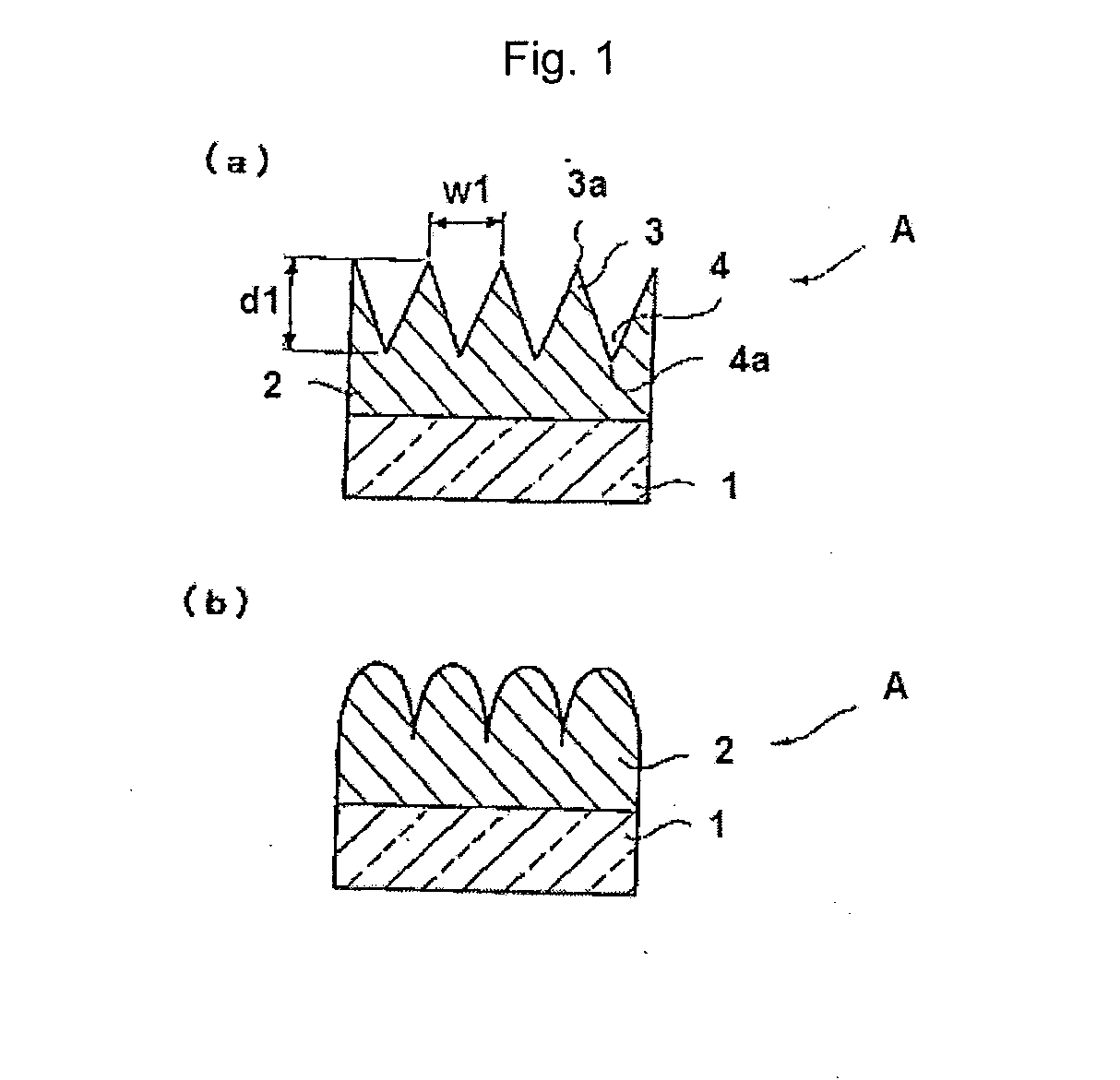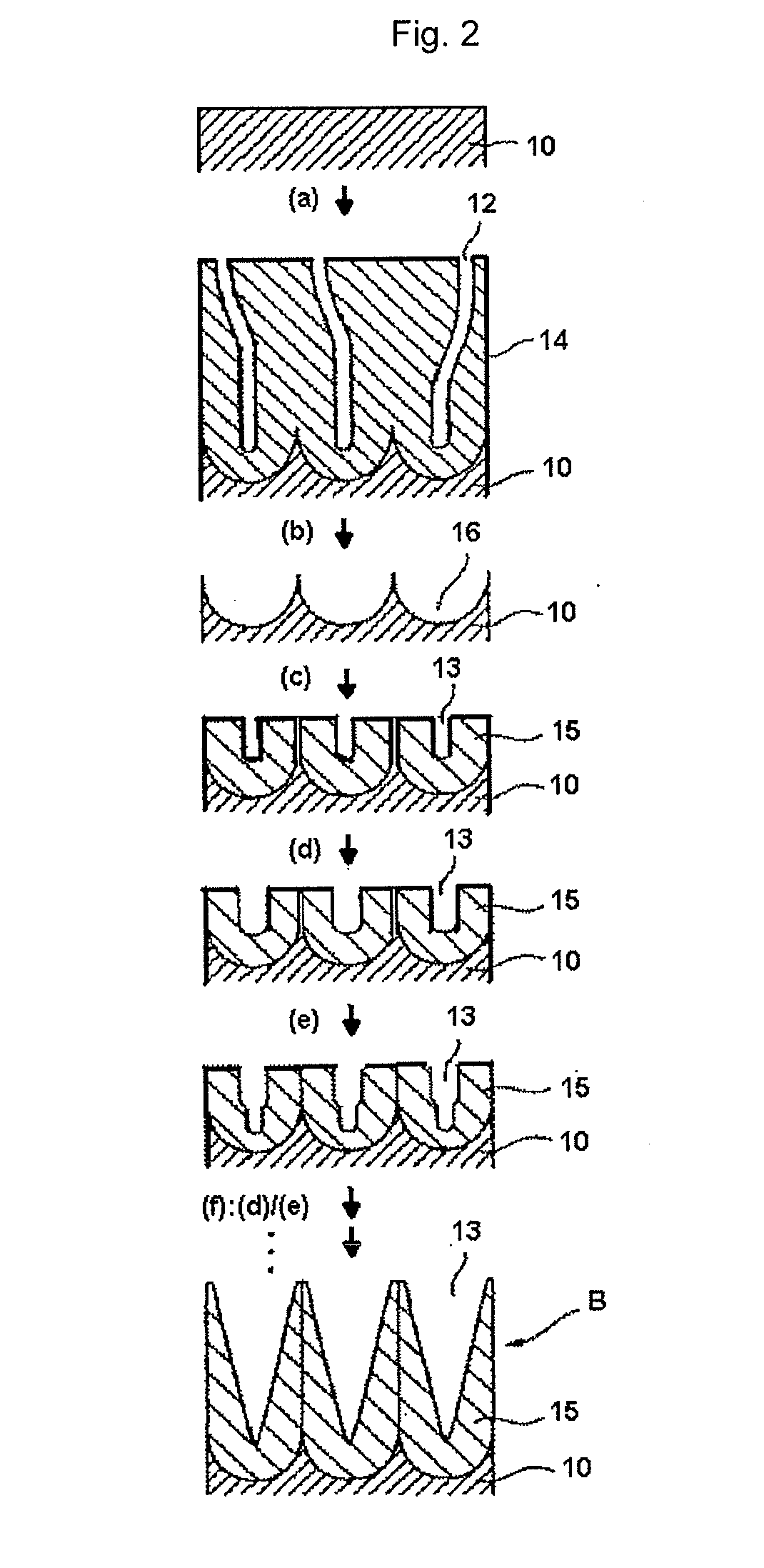Active energy ray-curable resin composition, product having the uneven microstructure, and method for producing product having the uneven microstructure
a technology of active energy raycurable resin and resin composition, which is applied in the direction of manufacturing tools, instruments, transportation and packaging, etc., can solve the problems of limited use, not always satisfying scratch resistance, and durability in use, and achieves excellent scratch resistance, high anti-reflective effect, and high decontamination effect
- Summary
- Abstract
- Description
- Claims
- Application Information
AI Technical Summary
Benefits of technology
Problems solved by technology
Method used
Image
Examples
production example 1
Production of Stamper (Depth of 180 nm)
[0180]With reference to the process drawing shown in FIG. 2, a method for producing a stamper will be described below.
[0181]An aluminum plate 30 having a purity of 99.99% was buffed and electropolished in perchloric acid / ethanol mixed solution (volume ratio of 1 / 4) to a mirror-finish.
Step (a)
[0182]The aluminum plate 30 was subjected to anode oxidation in a 0.3 M oxalic acid aqueous solution at a DC of 40 V and a temperature of 16° C. for 30 minutes to produce cracks 31 in an oxide coating 32.
Step (b)
[0183]The aluminum plate 30 was immersed in a 6% by mass phosphoric acid / 1.8% by mass chromic acid mixed aqueous solution for 6 hours to remove the oxide coating 32.
Step (c)
[0184]The aluminum plate was subjected to anode oxidation in a 0.3 M oxalic acid aqueous solution at a DC of 40 V and temperature of 16° C. for 30 seconds to form an oxide coating 34. The oxide coating 34 had pores 31.
Step (d)
[0185]The aluminum plate having the oxide coating 34 f...
production example 2
Production of Stamper (Depth of 150 nm)
[0187]An anodized porous alumina having approximately conical pores having a cycle of 100 nm and a depth of 150 nm was obtained in the same manner as in Production Example 1 except that the phosphoric acid treatment time in Step (d) was changed from 8 minutes to 9 minutes.
[Polymerization Reactive Monomer Component]
synthesis example 1
Synthesis of Urethane Acrylate Compound (UA1)
[0188]In a glass flask, 117.6 g (0.7 mol) of hexamethylene diisocyanate, 151.2 g (0.3 mol) of an isocyanurate type hexamethylene diisocyanate trimer, 128.7 g (0.99 mol) of 2-hydroxy propyl acrylate, and 459 g (1.54 mol) of pentaerythritol triacrylate were placed. 100 ppm of di-n-butyltin dilaurate as a catalyst and 0.55 g of hydroquinone monomethyl ether as a polymerization inhibitor were charged therein. These were reacted on the condition of 70 to 80° C. until the concentration of the remaining isocyanate reached 0.1% or less. Thus, urethane acrylate compound (UA1) was obtained.
[0189]The multifunctional monomers (A) used in Examples 1 to 17 and Comparative Examples 1 to 5 and the value obtained by dividing the molecular weight of the multifunctional monomer (A) by the number of radical polymerizable functional groups (molecular weight per functional group) in each of the multifunctional monomers (A) are shown in Table 1.
TABLE 1Multifunc...
PUM
| Property | Measurement | Unit |
|---|---|---|
| viscosity | aaaaa | aaaaa |
| viscosity | aaaaa | aaaaa |
| viscosity | aaaaa | aaaaa |
Abstract
Description
Claims
Application Information
 Login to View More
Login to View More - R&D
- Intellectual Property
- Life Sciences
- Materials
- Tech Scout
- Unparalleled Data Quality
- Higher Quality Content
- 60% Fewer Hallucinations
Browse by: Latest US Patents, China's latest patents, Technical Efficacy Thesaurus, Application Domain, Technology Topic, Popular Technical Reports.
© 2025 PatSnap. All rights reserved.Legal|Privacy policy|Modern Slavery Act Transparency Statement|Sitemap|About US| Contact US: help@patsnap.com



